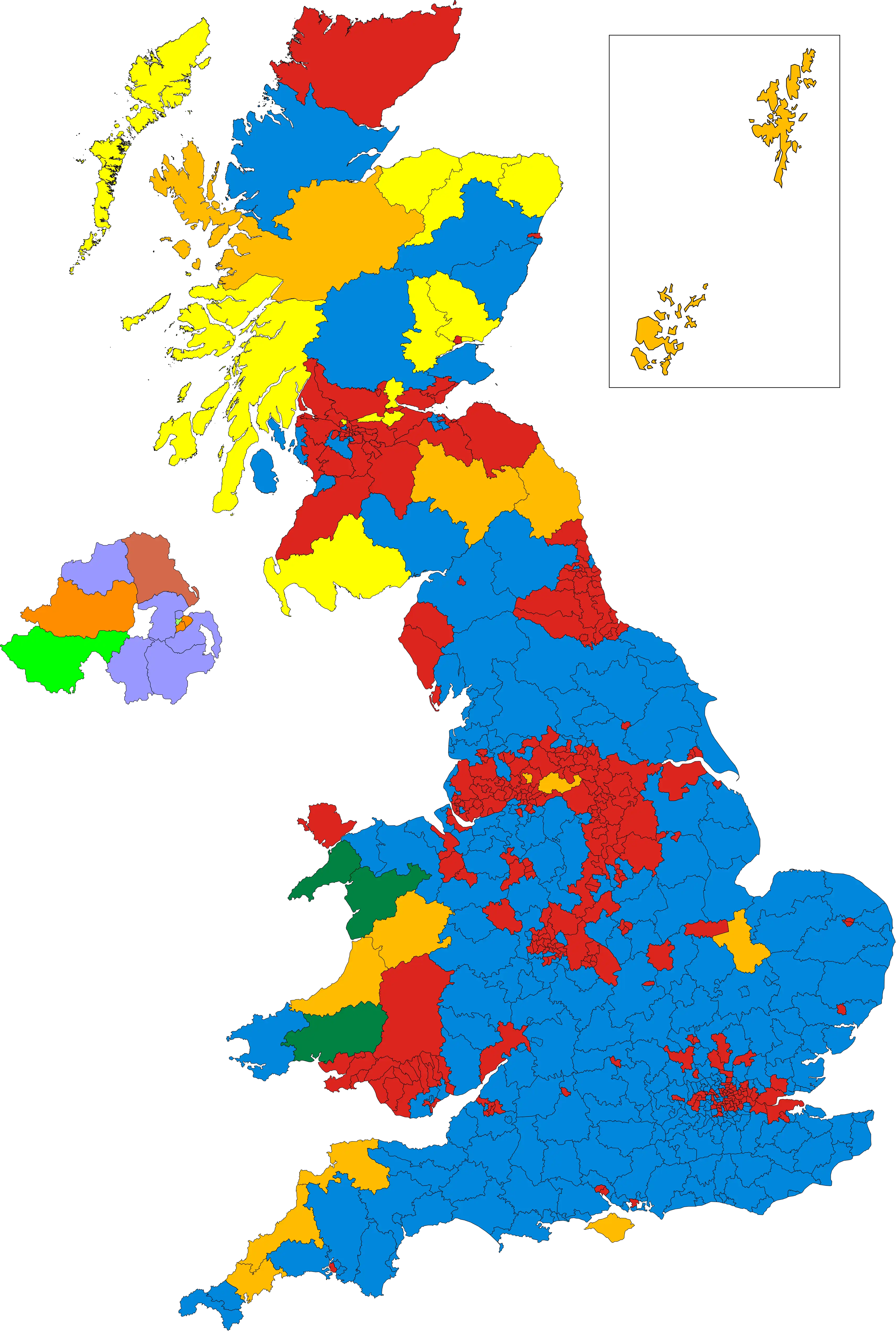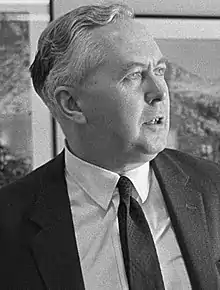| |||||||||||||||||||||||||||||||||||||||||||||
All 635 seats in the House of Commons 318 seats needed for a majority | |||||||||||||||||||||||||||||||||||||||||||||
|---|---|---|---|---|---|---|---|---|---|---|---|---|---|---|---|---|---|---|---|---|---|---|---|---|---|---|---|---|---|---|---|---|---|---|---|---|---|---|---|---|---|---|---|---|---|
| Opinion polls | |||||||||||||||||||||||||||||||||||||||||||||
| Turnout | 72.8%, | ||||||||||||||||||||||||||||||||||||||||||||
| |||||||||||||||||||||||||||||||||||||||||||||
 Colours denote the winning party—as shown in § Results | |||||||||||||||||||||||||||||||||||||||||||||
 Composition of the House of Commons after the election | |||||||||||||||||||||||||||||||||||||||||||||
| |||||||||||||||||||||||||||||||||||||||||||||
The October 1974 United Kingdom general election took place on Thursday 10 October 1974 to elect 635 members of the British House of Commons. It was the second general election held that year; the first year that two general elections were held in the same year since 1910; and the first time that two general elections were held less than a year apart from each other since the 1923 and 1924 elections, which took place 10 months apart. The election resulted in the Labour Party, led by Prime Minister Harold Wilson, winning a bare majority of three seats. That enabled the remainder of the Labour government to take place, but it saw a gradual loss of its majority.
The election of February that year had produced an unexpected hung parliament. Coalition talks between the Conservatives and other parties such as the Liberals and the Ulster Unionists failed, which allowed Wilson to form a minority government. The October campaign was not as vigorous or exciting as the one in February. Despite continuing high inflation, Labour boasted that it had ended the miners' strike, which had dogged Heath's premiership, and had returned some stability. The Conservative Party, still led by former Prime Minister Edward Heath, released a manifesto promoting national unity, but its chances of forming a government were hindered by the Ulster Unionist Party refusing to take the Conservative whip at Westminster in response to the Sunningdale Agreement of 1973.
Both the Conservatives and the Liberals saw their vote share decline, and the Conservative Party leader, Edward Heath, who had lost three of the four elections that he contested, was ousted as party leader in February 1975 and replaced with future Prime Minister Margaret Thatcher. The Scottish National Party won 30% of the Scottish popular vote and 11 of Scotland's 71 seats in the party's most successful general election result until 2015.
Subsequently, Labour's narrow parliamentary majority had disappeared by 1977 by a series of by-election losses and defections. It then required deals with the Liberals, the Ulster Unionists, the Scottish Nationalists and the Welsh Nationalists.
It was the last general election victory for the Labour Party until 1997. Each of the next four consecutive general elections produced a Conservative parliamentary majority. It would also be the last time Labour won more seats at a national election than the Conservatives until the 1989 European Parliament election. This remains the most recent General Election that Labour made net gains in seats whilst in government.
The election was broadcast live on the BBC and was presented by David Butler, Alastair Burnet, Robert McKenzie, Robin Day and Sue Lawley.[1]
Campaign
The brief period between the elections gave Wilson the opportunity to demonstrate reasonable progress. Despite high inflation and high balance-of-trade deficits, the miners' strike, which had dogged Heath was over, and some stability had been restored. After the February election, Heath had remained largely out of the public eye.
As was expected, the campaign was not as exciting as the one in February, and overall coverage by broadcasters was significantly scaled back. The Conservatives campaigned on a manifesto of national unity in response to the mood of the public. Labour campaigned on its recent successes in government, and although the party was divided over Europe, the party's strengths outweighed that of Heath, who knew that his future relied on an election victory. Devolution was a key issue for the Liberals and the Scottish National Party, and it was now one that the two main parties also felt the need to address. The Liberals did not issue a new manifesto but simply reissued the one they had created for the last election.[2][3]
Timeline
Prime Minister Harold Wilson made a ministerial broadcast on television on 18 September to announce that the election would be held on 10 October, less than eight months since the previous election. The key dates were as follows:
| Friday 20 September | Dissolution of the 46th Parliament and campaigning officially begins |
| Monday 30 September | Last day to file nomination papers |
| Wednesday 9 October | Campaigning officially ends |
| Thursday 10 October | Polling day |
| Friday 11 October | The Labour Party wins control with a majority of 3 |
| Tuesday 22 October | 47th Parliament assembles |
| Tuesday 29 October | State Opening of Parliament |
Results
Labour achieved a swing of 2% against the Conservatives. It was the first time since 1922 that a government had won an overall majority with less than 40% of the vote, but the majority of only three seats. The Conservatives won just under 36% of the vote, their worst share since 1918. A slight drop in the Liberals' vote saw them suffer a net loss of one seat. In Scotland, the Scottish National Party added another 4 seats to their successes in the previous election and became the fourth-largest party.
Turnout was 72.8%, which was a significant decline on the February election's 78.8% turnout.
_UK_parliament.svg.png.webp)
| Candidates | Votes | ||||||||||
|---|---|---|---|---|---|---|---|---|---|---|---|
| Party | Leader | Stood | Elected | Gained | Unseated | Net | % of total | % | No. | Net % | |
| Labour | Harold Wilson | 623 | 319 | 19 | 1 | +18 | 50.2 | 39.2 | 11,457,079 | +2.0 | |
| Conservative | Edward Heath | 622 | 277[note 1] | 2 | 22 | −20 | 43.6 | 35.8 | 10,462,565 | −2.1 | |
| Liberal | Jeremy Thorpe | 619 | 13 | 1 | 2 | −1 | 2.1 | 18.3 | 5,346,704 | −1.0 | |
| SNP | William Wolfe | 71 | 11 | 4 | 0 | +4 | 1.7 | 2.9 | 839,617 | +0.9 | |
| Ulster Unionist | Harry West | 7 | 6 | 0 | 1 | −1 | 0.9 | 0.9 | 256,065 | +0.1 | |
| Plaid Cymru | Gwynfor Evans | 36 | 3 | 1 | 0 | +1 | 0.5 | 0.6 | 166,321 | +0.1 | |
| SDLP | Gerry Fitt | 9 | 1 | 0 | 0 | 0 | 0.2 | 0.6 | 154,193 | +0.1 | |
| National Front | John Kingsley Read | 90 | 0 | 0 | 0 | 0 | 0.4 | 113,843 | +0.2 | ||
| Vanguard | William Craig | 3 | 3 | 0 | 0 | 0 | 0.5 | 0.3 | 92,262 | +0.1 | |
| DUP | Ian Paisley | 2 | 1 | 0 | 0 | 0 | 0.2 | 0.3 | 59,451 | +0.1 | |
| Alliance | Oliver Napier | 5 | 0 | 0 | 0 | 0 | 0.2 | 44,644 | +0.1 | ||
| Independent Labour | N/A | 7 | 0 | 0 | 1 | −1 | 0.2 | 33,317 | +0.1 | ||
| Independent Republican | N/A | 1 | 1 | 1 | 0 | +1 | 0.2 | 0.2 | 32,795 | +0.2 | |
| Republican Clubs | Tomás Mac Giolla | 5 | 0 | 0 | 0 | 0 | 0.1 | 21,633 | +0.1 | ||
| Unionist Party NI | Brian Faulkner | 2 | 0 | 0 | 0 | 0 | 0.1 | 20,454 | N/A | ||
| Communist | John Gollan | 29 | 0 | 0 | 0 | 0 | 0.1 | 17,426 | 0.0 | ||
| Democratic Labour | Dick Taverne | 1 | 0 | 0 | 1 | −1 | 0.1 | 13,714 | +0.1 | ||
| NI Labour | Alan Carr | 3 | 0 | 0 | 0 | 0 | 0.0 | 11,539 | 0.0 | ||
| Independent | N/A | 32 | 0 | 0 | 0 | 0 | 0.0 | 8,812 | −0.1 | ||
| Independent Ulster Unionist | N/A | 1 | 0 | 0 | 0 | 0 | 0.0 | 4,982 | N/A | ||
| United Democratic | James Tippett | 13 | 0 | 0 | 0 | 0 | 0.0 | 4,810 | N/A | ||
| Ind. Conservative | N/A | 4 | 0 | 0 | 0 | 0 | 0.0 | 4,559 | 0.0 | ||
| More Prosperous Britain | Tom Keen and Harold Smith | 25 | 0 | 0 | 0 | 0 | 0.0 | 4,301 | 0.0 | ||
| Workers Revolutionary | Gerry Healey | 10 | 0 | 0 | 0 | 0 | 0.0 | 3,404 | 0.0 | ||
| Independent Liberal | N/A | 3 | 0 | 0 | 0 | 0 | 0.0 | 3,277 | −0.2 | ||
| Volunteer Political | Ken Gibson | 1 | 0 | 0 | 0 | 0 | 0.0 | 2,690 | N/A | ||
| Irish Civil Rights | N/A | 7 | 0 | 0 | 0 | 0 | 0.0 | 2,381 | N/A | ||
| PEOPLE | Tony Whittaker | 5 | 0 | 0 | 0 | 0 | 0.0 | 1,996 | 0.0 | ||
| Marxist-Leninist (England) | John Buckle | 8 | 0 | 0 | 0 | 0 | 0.0 | 1,320 | 0.0 | ||
| English National | Frank Hansford-Miller | 2 | 0 | 0 | 0 | 0 | 0.0 | 1,115 | N/A | ||
| United English National | John Kynaston | 1 | 0 | 0 | 0 | 0 | 0.0 | 793 | N/A | ||
| Marxist–Leninist (Ireland) | Carole Reakes | 3 | 0 | 0 | 0 | 0 | 0.0 | 540 | N/A | ||
| Mebyon Kernow | Richard Jenkin | 1 | 0 | 0 | 0 | 0 | 0.0 | 384 | N/A | ||
| Socialist (GB) | N/A | 1 | 0 | 0 | 0 | 0 | 0.0 | 118 | N/A | ||
| Government's new majority | 3 |
| Total votes cast | 29,189,104 |
| Turnout | 72.8% |
Votes summary
Seats summary
Incumbents defeated
See also
Notes
References
- ↑ Election 1974 (October) – Part 1 on YouTube, UK General Election 1974 – Results Round-up on YouTube
- ↑ 1974 Oct: Wilson makes it four, BBC News, 5 April 2005, retrieved 8 June 2018
- ↑ "10 October 1974", BBC Politics 97, retrieved 8 June 2018
- ↑ Elected as a Labour MP
- ↑ Elected as a Labour MP
- ↑ Elected as a Labour MP
- ↑ Elected as a Labour MP
Further reading
- Butler, David E.; et al. (1975), The British General Election of October 1974, the standard scholarly study
- Craig, F. W. S. (1989), British Electoral Facts: 1832–1987, Dartmouth: Gower, ISBN 0900178302
External links
Manifestos
- Putting Britain First, October 1974 Conservative Party manifesto
- Britain Will Win With Labour, October 1974 Labour Party manifesto
- Why Britain Needs Liberal Government, October 1974 Liberal Party manifesto

.jpg.webp)

.jpg.webp)